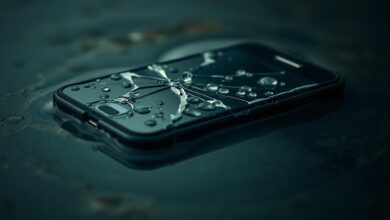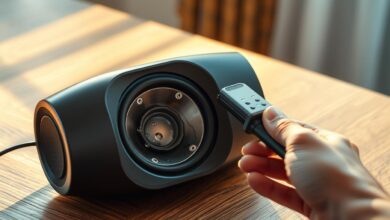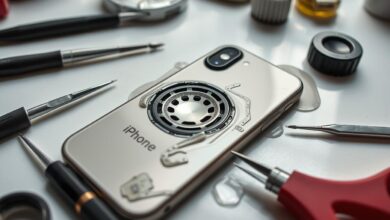
Dealing with iPhone speaker problems can be really frustrating. It’s especially tough when you don’t know what’s wrong or how to fix it. If you’re facing no sound, distorted audio, or volume that changes too much, this guide is here to help.
I’m an expert in fixing iPhones, and I’m here to share my knowledge. I’ll show you how to fix your speaker issues quickly and easily. This guide will walk you through different ways to make your iPhone’s speaker work right again.
Key Takeaways
- Identify common causes of iPhone speaker issues
- Learn basic troubleshooting steps for speaker problems
- Discover methods to repair or resolve speaker issues
- Understand when to seek professional help for complex problems
- Prevent future speaker issues with maintenance tips
Understanding Your iPhone’s Speaker System
Before we start fixing iPhone audio issues, let’s learn about the speaker system. The iPhone’s speakers are not just one thing. They are many parts working together to make sound.
Top vs. Bottom Speaker Functions
The iPhone has two main speakers: the top and bottom ones. The bottom speaker plays sound when you watch videos or listen to music. The top speaker is for call audio, so you can hear the other person clearly.
How iPhone Speakers Work
iPhone speakers turn electrical signals into sound waves. This happens through several parts like the speaker drivers, amplifiers, and grills. When you play audio, the electrical signal goes to the speaker driver. It vibrates to make sound waves.
Common Speaker Components That Fail
Several parts can fail and cause sound problems. These include:
- Speaker grills that are clogged with debris
- Internal speaker components that are damaged or worn out
- Loose or damaged cables connecting the speakers
Knowing about these parts helps you find and fix speaker issues on your iPhone.
Signs Your iPhone Speaker Needs Fixing
Knowing when your iPhone speaker is broken can help you fix it fast. If your iPhone’s speaker isn’t working right, it’s really annoying. Especially when you don’t know why.
No Sound Issues
If your iPhone speaker doesn’t make any sound, it’s a big problem. This can happen during calls, when playing music or videos, or any other time you try to listen.
Distorted Audio Problems
Distorted audio is just as bad as no sound at all. Common problems include crackling, buzzing, or fuzzy sounds. These can really mess up your listening experience.
Volume Inconsistencies
Volume that changes a lot is another sign of trouble. These changes can happen:
- During Calls: When the volume goes up and down or is too low.
- While Playing Media: When the volume of music or videos is all over the place or too quiet.
During Calls
Low or changing volume during calls means your speaker might be broken. This can make talking on the phone really hard.
While Playing Media
Also, if the volume is off when playing media, it could be a speaker problem. First, check your volume settings. Make sure nothing is blocking the speaker grills.
Before You Begin: Preparation Steps
Before starting the iPhone speaker repair, prepare your device and gather tools. This step ensures a smooth repair process.
Tools You Might Need
You’ll need a few key tools to begin. These include a screwdriver, a spudger, and a cleaning cloth. Having these tools ready makes the repair easier and avoids complications.
Safety Precautions
Take safety steps to avoid damaging your iPhone. Grounding yourself is a good practice. You can do this by touching a metal object or wearing an anti-static wrist strap.
Backing Up Your iPhone
Before starting, make sure to back up your iPhone. This step prevents data loss during the repair. Back up using iCloud or iTunes.
By following these steps, you’re ready to repair or replace your iPhone’s speaker. This ensures a successful outcome.
Quick Fixes for iPhone Speaker Issues
Before you try complex repairs, try some simple fixes for your iPhone speaker. Sometimes, just changing a setting or turning off a feature can solve the problem.
Checking Volume Settings and Restrictions
First, make sure your iPhone’s volume isn’t too low or muted. Check the volume buttons and the Settings app. Ensure the volume is up and there are no volume limits. Also, check Settings > Music > Volume Limit to avoid volume restrictions.
Toggling Silent Mode and Do Not Disturb
It could be that your iPhone is in Silent Mode or Do Not Disturb. Turn these off to see if they’re the problem. You can find these in the Control Center or Settings.
Disconnecting Bluetooth Devices
Bluetooth can sometimes mess with your iPhone’s speaker. Try disconnecting any Bluetooth devices. Go to Settings > Bluetooth and turn off any connected devices.
Removing Headphone Mode Glitch
If your iPhone is stuck in headphone mode, it won’t play sound through the speakers. Try plugging and unplugging your headphones a few times or restart your iPhone. If it still doesn’t work, you might need to clean the headphone jack or visit a repair shop.
By trying these quick fixes, you might fix your iPhone speaker issues without needing more repairs. If the problem continues, you might need to try more troubleshooting steps or get professional help.
How to Fix iPhone Speaker Through Software Solutions
Software glitches can cause iPhone speaker problems. Luckily, fixing them is easier than you might think. Before looking at hardware repairs, try software troubleshooting steps first.
Restarting Your iPhone
Restarting your iPhone can fix minor software issues. Press and hold the sleep/wake button until you see “Slide to Power Off.” Drag it to the right, then wait a few seconds. Press and hold the sleep/wake button again until you see the Apple logo.
Updating iOS to Latest Version
Updating your iPhone to the latest iOS can fix bugs and improve performance. Go to Settings > General > Software Update to download and install the latest version.
Resetting All Settings
Resetting all settings can fix configuration issues affecting your speaker. Go to Settings > General > Reset and choose “Reset all settings.” This will reset your iPhone’s settings to default.
Audio Settings to Check
After resetting, check your audio settings. Make sure the volume is up and EQ settings are at default. Go to Settings > Music > EQ and choose “Off.”
Accessibility Settings Impact
Accessibility settings can also affect your speaker. Check Settings > Accessibility > Audio/Visual for settings like Mono Audio or Phone Noise Cancellation.
Trying these software solutions can fix your iPhone speaker issues without hardware repairs. If problems continue, you might need to look further or get professional help.
Cleaning Your iPhone Speaker
iPhone speaker problems often come from dirt, dust, or water. Cleaning is key to fixing these issues. Dirt or water can mess up your sound, making it distorted or silent.
Safe Cleaning Methods
To clean your iPhone speaker safely, use a soft-bristled brush or a cleaning cloth. Stay away from sharp objects or liquids that could harm the speaker. Gently sweep or wipe the speaker grills to get rid of debris.
Removing Debris from Speaker Grills
Debris in the speaker grills is common and can be fixed with cleaning. Use a small, dry brush to remove dust and dirt. For tough debris, compressed air can help blow it out.
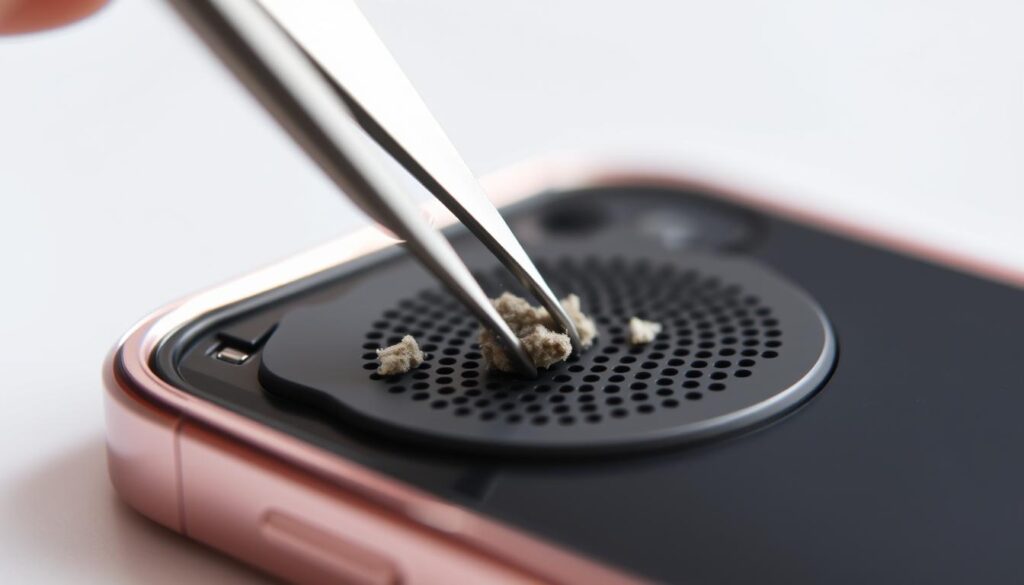
Dealing with Water and Liquid Damage
If your iPhone gets wet, act fast to prevent damage. First, turn off your device and take off any accessories.
Emergency Steps
Use a soft cloth to dry the outside of your iPhone. Don’t press buttons or open the SIM card tray until it’s dry.
Long-term Recovery
For lasting recovery, use desiccants or silica gel packets to dry out moisture. You can also use a drying device made for electronics.
| Cleaning Method | Effectiveness | Safety |
|---|---|---|
| Soft-bristled brush | High | Safe |
| Compressed air | Medium | Caution advised |
| Liquid cleaners | Low | Not recommended |
By following these steps and using the right cleaning methods, you can fix your iPhone speaker problems. This will improve your device’s sound quality.
Troubleshooting iPhone Speaker Not Working
Fixing your iPhone’s speaker problems needs a step-by-step plan. It’s important to check everything carefully to find the main cause.
Diagnostic Tests to Run
First, test your iPhone’s speaker. Play music or a video to see if sound comes from the speaker. If not, try looking for stuck or greyed-out speaker.
Using Sound Check Features
iOS has features like Sound Check to find audio problems. Go to Settings > Music and turn on “Sound Check.” It balances music volume, helping you find the problem.
Testing Different Audio Sources
Try different sounds to see if the problem is with all media. Play music, videos, or make calls to test the speaker. If it doesn’t work with anything, it might be a hardware issue. But if it only happens with certain apps, it could be a software problem.
Identifying Hardware vs. Software Issues
It’s key to know if the problem is with the hardware or software. Software issues can be fixed with updates or resets. But hardware problems might need repairs or a new part. By doing tests and looking at the results, you can figure out what’s wrong and how to fix it.
Fixing iPhone Speaker Not Loud Enough
Having an iPhone speaker that’s not loud enough can be really frustrating. It can mess up your experience, whether you’re watching videos, listening to music, or making calls. Luckily, there are several things you can try to fix it.
Adjusting EQ and Sound Settings
Start by tweaking the EQ and sound settings. Head to Settings > Music > EQ and play around with the equalizer. Some settings, like “Late Night,” can make your music sound louder. Also, make sure the volume limit isn’t too low or turned on.
Using Sound Amplification Features
iOS has features to boost sound. Check if Sound Check is on by going to Settings > Music. This feature balances your music’s volume, which might help if some songs are too quiet.
Third-Party Volume Booster Apps
If the built-in settings don’t work, try third-party apps. Apps like Boom: Volume Booster & Equalizer or Volume Booster PRO can up your iPhone’s volume. But, be careful not to turn it up too high to avoid damaging your speaker.
Checking for Volume Limiters
Volume limiters can also reduce your iPhone’s volume. Go to Settings > Music > Volume Limit to check. If it’s on, adjust or turn it off to see if it fixes the problem. This is especially true if you’ve set a volume limit before and forgot about it.
By trying these steps, you might be able to fix your iPhone speaker’s volume. This could make your overall experience much better.
How to Fix iPhone Speaker Crackling and Distortion
Dealing with iPhone speaker crackling and distortion can be annoying. The first step is to find out why it’s happening. It could be a software glitch or a hardware problem.
Common Causes of Audio Distortion
Several things can cause audio distortion in iPhones. Debris or dust in the speaker grills, water damage, or software issues are common culprits. Knowing the cause helps you fix it right.
Experts say hardware issues like blocked speaker grills or damaged parts are often the main problem. Keeping your iPhone’s speaker grills clean is a simple but effective solution.
Software-Based Solutions
Software adjustments can sometimes solve the problem. Updating your iOS to the latest version or resetting all settings can help. Apple recommends keeping your device updated for the best performance.
To update your iOS, go to Settings > General > Software Update. If an update is there, just follow the instructions to download and install it.
Hardware Inspection for Crackling
If software fixes don’t work, you need to check the hardware. Look for any connection issues or damage to the speaker parts.
Connection Issues
Loose connections can make your speaker crackle. Make sure all internal parts are well connected to solve the problem.
Physical Damage Assessment
Physical damage, like from drops or water, can also cause distortion. Checking how bad the damage is will tell you if you need to repair or replace something.
In conclusion, fixing iPhone speaker crackling and distortion needs a careful approach. Start by figuring out the cause and then use the right software or hardware fix. By doing this, you can get your iPhone’s sound back to normal.
Advanced Troubleshooting for Persistent Issues
For tough iPhone audio problems, advanced troubleshooting can help a lot. When simple fixes don’t work, it’s time to explore more solutions.
Force Restarting Your iPhone
A force restart can fix deep software issues that make your iPhone speaker not work. Press the volume up button, then the volume down button. Finally, hold the side button until it restarts.
DFU Mode Restoration
If a force restart doesn’t fix it, try a DFU (Device Firmware Update) mode restoration. This resets your iPhone to its original settings, fixing software problems. But, it will delete all your data, so back up first.
Factory Reset Considerations
A factory reset is a big step that removes all data from your iPhone. Make sure to back up your important stuff before. If you’re ready, go to Settings > General > Reset > Erase All Content and Settings.
Testing in Safe Mode
Try your iPhone in safe mode to see if a third-party app is the problem. If it works in safe mode, an app is probably causing the issue.
DIY iPhone Speaker Repair Options
Want to save money and learn something new? Trying a DIY iPhone speaker repair might be for you. It needs some technical know-how and caution but can fix speaker problems.
Opening Your iPhone Safely
To start the DIY repair, you must safely open your iPhone. This is key and needs the right tools to avoid more damage. Make sure to use a guide for your iPhone model to understand its design.
Inspecting Internal Speaker Components
After opening your iPhone, carefully check the internal speaker parts. Look for damage, corrosion, or dirt that might be the problem. This step is vital to find the main issue.
| Component | Common Issues | Potential Fixes |
|---|---|---|
| Speaker Unit | Physical damage, debris | Cleaning, replacement |
| Cables | Loose connections | Reconnecting |
| Internal Components | Corrosion, dust | Cleaning, drying |
Reconnecting Loose Cables
At times, the problem is just a loose cable connection. Check the cables to the speaker and reconnect them if loose. This can fix connectivity issues and make the speaker work again.
Cleaning Internal Components
Cleaning the inside of your iPhone, including the speaker, can make it work better. Use the right tools and methods to get rid of dirt and dust. Be careful not to harm any parts while cleaning.
By doing these DIY steps, you might fix your iPhone speaker without professional help. But if you’re unsure, it’s best to get help from a pro to avoid more damage.
iPhone Speaker Replacement Guide
If your iPhone speaker is damaged, you might need to replace it to get clear sound again. Replacing the speaker is easy with the right guide.
When Replacement is Necessary
Not every speaker problem can be fixed with simple fixes or cleaning. If your speaker is physically damaged or has water damage, it’s best to replace it. Look for signs like persistent distortion, no sound, or visible damage to the speaker grille.
Finding the Right Replacement Parts
To replace your speaker right, you need the correct parts for your iPhone model. Check your iPhone model number to find compatible parts. You can buy from trusted suppliers or Apple, if they have them.
| iPhone Model | Speaker Type | Replacement Difficulty |
|---|---|---|
| iPhone 12 | Dual Speaker | Moderate |
| iPhone 13 | Stereo Speaker | High |
| iPhone 14 | Stereo Speaker | High |
Step-by-Step Replacement Process
Tools Required
- Pentalobe screwdriver
- Phillips screwdriver
- Plastic spudger
- Tweezers
Disassembly Sequence
- Power off your iPhone and remove the SIM card tray.
- Remove the pentalobe screws at the bottom.
- Carefully pry open the iPhone using a plastic spudger.
- Disconnect the battery and then the display cables.
- Locate the speaker, disconnect its cables, and remove it.
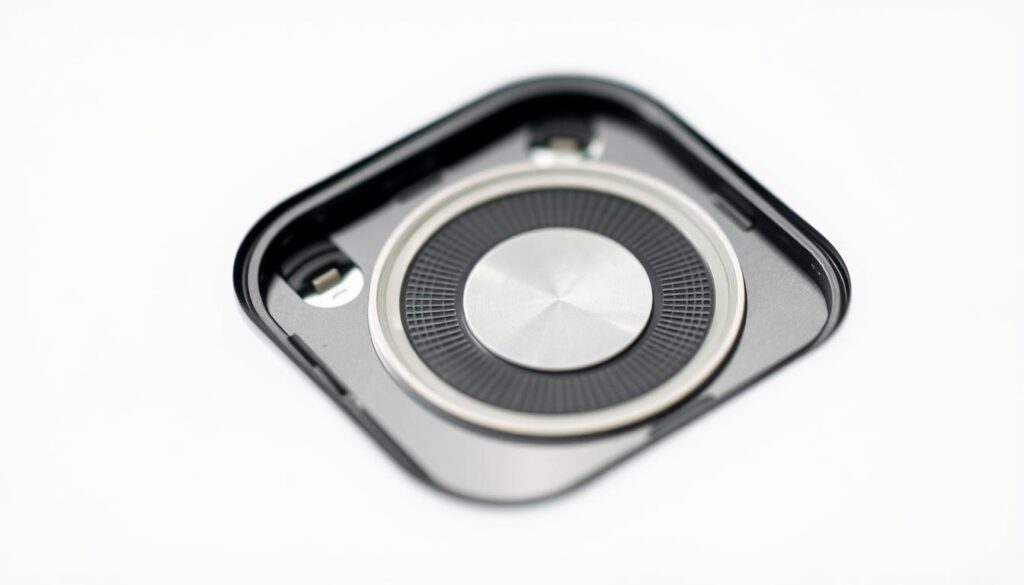
By following these steps and using the right tools, you can replace your iPhone speaker. This will fix your device’s audio problems.
Model-Specific Speaker Repair Tips
The iPhone’s speaker system changes with each model. Knowing these differences is key for fixing issues.
iPhone 13/14/15 Speaker Fixes
Fixing speakers on iPhone 13, 14, and 15 models is similar. A common problem is dirt in the speaker grills. Clean it with a soft-bristled brush.
These models can also get water damage. Dry the inside parts well before fixing or replacing the speaker.
iPhone 11/12 Speaker Solutions
iPhone 11 and 12 have different speakers than newer models. When fixing these, pay attention to the speaker’s placement and connections.
iPhone X/XS/XR Considerations
The iPhone X, XS, and XR have unique designs. Their speakers are in the front bezel. Be careful not to damage nearby parts when repairing.
Older iPhone Model Repairs
Repairing older iPhones might need more parts replaced. Always check specific guides for each model to fix it right.
| iPhone Model | Common Speaker Issues | Repair Considerations |
|---|---|---|
| iPhone 13/14/15 | Debris accumulation, water damage | Gentle cleaning, drying internal components |
| iPhone 11/12 | Speaker configuration issues | Model-specific component placement |
| iPhone X/XS/XR | Front bezel integration | Avoid damaging surrounding components |
When to Seek Professional iPhone Speaker Repair
If DIY fixes don’t work, it’s time to get professional help. Some problems just won’t go away, even after trying everything. That’s when you need an expert.
Apple Store vs. Third-Party Repair Shops
You can choose between an Apple Store or a third-party repair shop. Your decision depends on what you need, how much you want to spend, and if your device is still under warranty.
Apple Store: They use genuine parts and repairs are backed by a warranty. But, it might cost more.
Third-Party Repair Shops: They can be cheaper. But, make sure to pick a reliable service for good quality repairs.
Cost Considerations and Estimates
Think about the cost before getting your iPhone fixed. Get quotes from different places to make a smart choice.
“The cost of iPhone speaker repair can vary significantly depending on the model and the repair service chosen.”
Warranty and AppleCare Implications
Know how repairs affect your warranty and AppleCare. Repairs by unauthorized shops can cancel your warranty. Apple Store repairs usually keep it intact.
Finding Reputable Repair Services
Finding a reliable repair service is key. Look for reviews, ask for suggestions, and check for certifications. This ensures you’re in good hands.
By considering these points and picking the right service, you can get your iPhone speaker fixed right. This will make your device work like new again.
Preventing Future iPhone Speaker Problems
To avoid future iPhone speaker issues, you need to be proactive. This means using protective habits and regular maintenance. By doing so, your iPhone’s speaker will keep working well.
Protective Cases and Screen Protectors
Using protective cases and screen protectors is a smart move. They protect your iPhone from damage. These accessories can absorb shocks, prevent scratches, and keep water out, all helping your speaker stay in top shape.
Regular Maintenance Tips
Keeping your iPhone speaker clean is essential. Make sure to clean your speaker grills often. This removes dust and debris that can block sound. For more cleaning tips, check out our guide on fixing iPhone speaker issues.
Software Update Best Practices
It’s important to keep your iPhone’s software updated. Regular software updates fix bugs and improve performance. This helps prevent speaker problems.
Avoiding Common Damage Scenarios
Stay away from common damage risks like water or extreme temperatures. These can harm your iPhone and its speaker. By avoiding these, you’ll enjoy clear audio without interruptions.
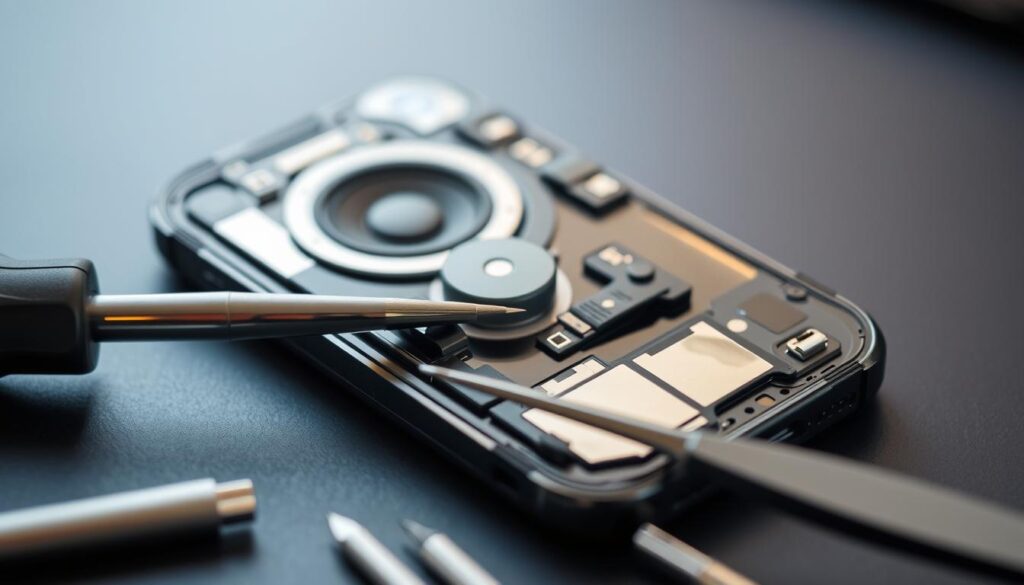
Conclusion
Fixing your iPhone speaker can be easy if you know what to do. Understanding your iPhone’s speaker system and troubleshooting common issues can help. This way, you can enjoy clear, distortion-free audio again.
In this guide, we’ve covered many ways to fix iPhone speaker problems. From simple software fixes to more complex hardware repairs, there are solutions. Whether you fixed it yourself or need professional help, the main point is that you can fix it with the right knowledge.
If you’re still having trouble after trying the steps in this article, it might be time to look into repair options. You can reach out to Apple support or visit a trusted repair service. Taking these steps can help restore your iPhone’s audio quality. You’ll be able to enjoy your music, videos, and calls without any problems.
FAQ
How do I fix my iPhone speaker if it’s not working?
First, check your volume settings and make sure silent mode is off. Also, disconnect any Bluetooth devices. If problems continue, try restarting your iPhone, updating your iOS, or resetting all settings.
Why is my iPhone speaker not loud enough?
Look at your EQ and sound settings. You might want to use sound amplification features or apps. Also, check for volume limiters that could be reducing your sound.
How do I clean my iPhone speaker?
Use a soft-bristled brush or a cleaning cloth to remove dirt from the speaker grills. Don’t use liquids or harsh chemicals, as they could harm your iPhone.
What should I do if my iPhone speaker is crackling or distorted?
First, check for debris or damage to the speaker. Try software fixes like updating your iOS or resetting settings. If problems still exist, look for hardware issues or damage.
Can I replace my iPhone speaker myself?
Yes, you can replace it yourself if you’re good at DIY repairs. Follow a step-by-step guide, and use the right tools and parts.
When should I seek professional help for my iPhone speaker repair?
If DIY and troubleshooting don’t work, or if you’re not comfortable with DIY, get professional help. Apple Stores or reputable repair shops can assist.
How can I prevent future iPhone speaker problems?
Use protective cases and screen protectors. Clean your speaker grills regularly. Follow software updates and avoid water or extreme temperatures.
Will a factory reset fix my iPhone speaker issues?
A factory reset might solve software problems, but it will erase your data. Try other fixes first before resetting.
Can water damage affect my iPhone speaker?
Yes, water damage can harm your iPhone speaker. If your iPhone gets wet, dry it out quickly. Consider long-term fixes to avoid further damage.
Are there any model-specific speaker repair tips for my iPhone?
Yes, different iPhone models need unique repair methods. Look for model-specific tips and guides to ensure the right repair for your iPhone.

